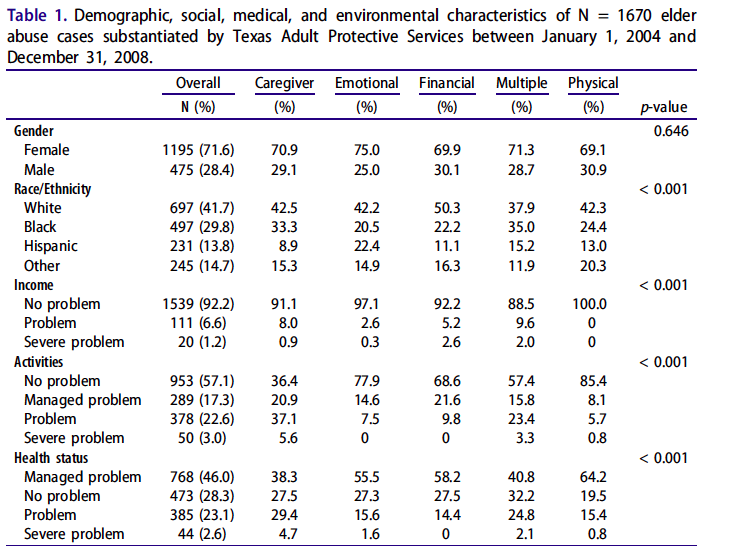
The occurrence of different types of elder abuse among cases substantiated by Texas Adult Protective Services. Credit: “Five-year all-cause mortality rates across five categories of substantiated elder abuse occurring in the community”
Recent research, published in the Journal of Elder Abuse & Neglect, estimated mortality risks by types of abuse by examining over 1,600 substantiated abuse cases in Texas.
Elder abuse can take many forms, and some are deadlier than others.
The paper identifies several categories of abuse: caregiver neglect; physical abuse; emotional abuse; financial exploitation; and polyvictimization; and proceeds to analyze the 5-year survival rates of those types of abuse.
From the paper:
As predicted, caregiver neglect had the highest mortality, with approximately 35% percent of the caregiver neglect victims having died by year four. Victims of caregiver neglect likely share the highest number of risk factors in common with mortality. Older adults needing caregiver services by definition have significant health problems (Acierno et al., 2010; Fulmer et al., 2005; Jackson & Hafemeister, 2011), and therefore may have lower physiological and psychological reserves to buffer against the consequences of caregiver neglect .
Perhaps the most interesting finding was regarding the deadly nature of financial exploitation:
There has been a tendency to characterize financial exploitation as less serious than physical violence (Nerenberg, 2000), a belief reflected in the finding that APS caseworkers were less likely to follow up in financial exploitation cases compared to other forms of elder abuse (Jackson & Hafemeister, 2012). However, our findings vehemently refute such characterizations.
Results showed that survival in cases of financial exploitation was not significantly different from those of caregiver neglect. Although victims of financial exploitation may be healthier than victims of caregiver neglect at the time of their substantiated victimization (Acierno et al., 2010; Jackson & Hafemeister, 2011), victims of financial exploitation may exhibit diminished cognitive functioning (Dong et al., 2014), and social isolation, such as living alone (Jackson & Hafemeister, 2011), which may contribute to their mortality (Dong et al., 2009; Steptoe et al., 2013). A study by Schofield et al. (2013) also found a link between financial exploitation and mortality among abused older women. In their study, the highest percentage of coercion reported was in the category of financial coercion.
The study was published in the March 2016 issues of Journal of Elder Abuse & Neglect. It was authored by Shelly L. Jackson PhD, of the University of Virginia; and Arup K. Sinha MS, Pamela Diamond PhD, Jason Burnett PhD, Kathleen Pace Murphy PhD, Rui Xia PhD and Andrew R. Aschenbrenner BS, MS, all of the University of Texas.
Read the full paper, titled “Five-year all-cause mortality rates across five categories of substantiated elder abuse occurring in the community“, by clicking here [subscription required].



